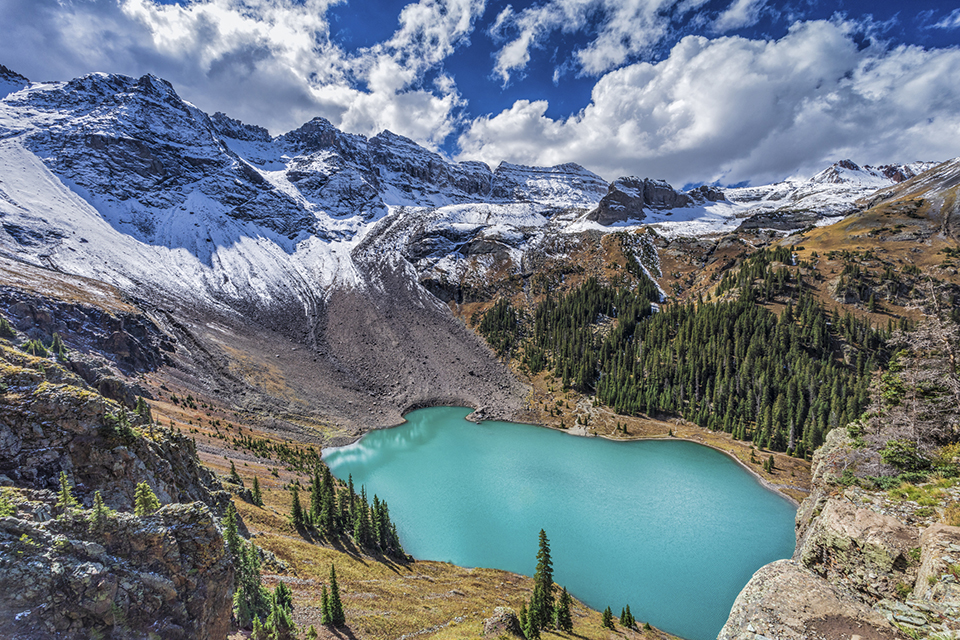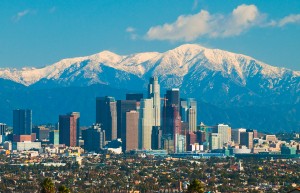CSUN Professors’ Research Rewrites Rocky Mountains’ Origin Story

A view from a ledge high above Lower Blue Lake in the Mount Sneffels Wilderness near Telluride, Colorado. Research by CSUN geologists Joshua Schwartz and Elena Miranda has blown a hole into the long-accepted hypothesis that the Rocky Mountains were born by a single collision between tectonic plates, or pieces of the Earth’s crust, 90 million years ago. Photo by lightphoto, iStock.
Like detectives tracking down clues in a decades-old cold case, a team of researchers led by California State University, Northridge geologists have blown a hole into the long-accepted hypothesis that the Rocky Mountains were born by a single collision between tectonic plates, or pieces of the Earth’s crust, 90 million years ago.
Instead, CSUN geological sciences professors Joshua Schwartz and Elena Miranda argue that the Rocky Mountains were formed during a two-stage event — likely from two separate collisions spanning the course of 50 million years beginning 90 million years ago and ending about 40 million years ago.

Joshua Schwartz
“This is a complete paradigm shift from we’ve always been taught about how the Rocky Mountains were created,” Schwartz said. “It’s been a commonly accepted hypothesis for decades that the Rocky Mountains were created by the repercussions of a single collision 90 million years ago between a continental plate and an oceanic plate somewhere along Southern California’s coast.”
The hypothesis was based on how the mountain ranges along the east and west coasts of North America were formed. Researchers made an assumption that the Rocky Mountains were similarly made.
“No one tested that assumption, until now,” Miranda said. “What we found is that assumption was wrong. There were actually two collisions that led to the creation of the Rocky Mountains. We found the evidence to support this hypothesis right here in our own backyard in Southern California, in our own San Gabriel Mountains.”
 Their findings, “Magmatic surge requires two-stage model for the Laramide orogeny,” can be found in the most recent publication of the journal Nature Communications. Their co-authors include Jade Star Lackey with the Department of Geology at Pomona College; Keith A. Klepeis and Gabriela Mora-Klepeis with the Department of Geography and Geosciences at the University of Vermont; and CSUN geological sciences students Francine Robles and Jonathan Bixler.
Their findings, “Magmatic surge requires two-stage model for the Laramide orogeny,” can be found in the most recent publication of the journal Nature Communications. Their co-authors include Jade Star Lackey with the Department of Geology at Pomona College; Keith A. Klepeis and Gabriela Mora-Klepeis with the Department of Geography and Geosciences at the University of Vermont; and CSUN geological sciences students Francine Robles and Jonathan Bixler.
The Rocky Mountains are the largest mountain belt in western North America, extending over 3,000 miles from western Canada to northern Mexico. The mountains’ origins are important because the Rockies are a strategic location for precious mineral resources such as gold, lead, copper and silver. They also are an important source of water recharge for the High Plains aquifer.
“A key problem in the geological history of the Rocky Mountains is that there is no consensus on when they rose, and why they are located so far from the present-day tectonic plate boundary between the Pacific and North American plates in California, Oregon and Washington,” Schwartz said. “Simply put, the Rockies are not where they should be.”
Schwartz and Miranda, who both teach in CSUN’s College of Science and Mathematics, said most geologic models attribute the rise of the Rockies to an ancient collision, known as a “flat-slab” collision, of an oceanic plateau with what is now Southern California 90 million years ago. The collision caused a “ripple,” or a series of thrust faults, that travelled hundreds of miles eastward to create the “bulges” in the Earth’s crust that we now know as the Rocky Mountains.
“You have to remember that this was the time of the dinosaurs and western coastal mountains were covered with volcanoes and there was a lot of magma (lava),” Schwartz said.
When tectonic collisions occur, Schwartz and Miranda explained, the areas of impact cool, leaving behind evidence — such as minerals which can now be dated — of what happened in the remaining rocks. If the original hypothesis of how the Rocky Mountains were formed was accurate, researchers would be able to find evidence of the ancient collision by dating minerals found in the rocks of Southern California.
“The reason why no one has really taken up this challenge before is that Southern California is home to the San Andreas Fault and dozens of other smaller faults, which basically means that you have to do a lot of rock collecting and dating before finding evidence to support, or disprove, the idea of a single collision that took place 90 million years ago,” Miranda said.

By using uranium-lead radiometric dating—a technique used to date materials such as rocks—of the mineral zircon in granite Miranda, Schwartz and their colleaagues found proof that a single, “flat-slab” collision could not be responsible for birth of the Rocky Mountains. Photo by Davel5957, iStock/
Miranda said the travel restrictions during the COVID-19 pandemic provided a perfect opportunity for the Southern California researchers to scour the local mountains, particularly the San Gabriels, for evidence of the ancient collision.
“It was like trying to put a puzzle together from a giant box that included pieces from dozens of other puzzles, but we were able to do it,” Miranda said.
Using uranium-lead radiometric dating—a technique used to date materials such as rocks—of the mineral zircon in granite the researchers found proof that a single, “flat-slab” collision could not be responsible for birth of the Rocky Mountains.
Instead, the researchers propose that the Rocky Mountains were formed during a two-stage event, two separate collisions taking place nearly 20 million years apart. The first took place about 90 million years ago further north along California’s coast and caused the northern portion of what we now call the Rocky Mountains to be created. The second collision took place about 70 million years later along Southern California’s coast, which extended the Rocky Mountains south.
“Our new data answers key questions about the time and location of the Rocky Mountains and provide the missing pieces of the puzzle because they show that multiple driving mechanisms are required to explain the Laramide orogeny (the time period of mountain building in western North America),” Schwartz said.
When the researchers realized what they found, Miranda admitted to some “squealing” in the laboratory.
“Scientists can spend their entire careers working on research, but very few get the opportunity to change the conversation about such an important subject in their field,” she said.
Schwartz agreed.
“In a way, our study represents a paradigm shift,” he said. “It redefines the growth of the Rocky Mountains.”
For the release in Spanish, click here.

 experience
experience